WattsUp
Well-known member
Yup, with the new larger battery pack I just had installed, after driving for a few hours today, I still had plenty of range left:
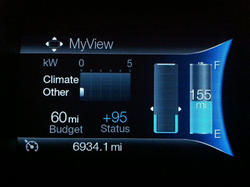
Hehe... okay, just kidding. :lol: I still have the normal battery pack. Actually, I went for a long mountainous drive today and, apparently, doing a lot of regen (down hills) really wreaks havoc with the FFE's range meter! It ends up very confused and estimates crazy big ranges.
For those of you familiar with a SF Bay Area, I drove my FFE along Skyline Blvd in the peninsula hills, following this route:
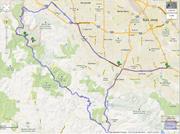
As you can see, there are many winding roads and, as you might surmise, significant elevation changes. At the beginning, after a bit of freeway and suburban driving, the initial climb is very windy. Then, Skyline Blvd (going basically south-east) rides along the tops of the hills and is (comparatively) flat with gentle curves. At the end, more windy roads (to descend) and then finally a trip (all down hill) on Hwy 17 back into Los Gatos.
I started the trip with a full charge and a range estimate of 97 miles (high, but not uncommon for me). After the initial climb, reaching Skyline Blvd, my status was down -30 (!) and the navi said I would have a surplus of only +16 miles upon reaching Hwy 17 (which I knew, if I could reach without dying, regen would get me home). I was a little nervous (having never driven this route in my FFE before) but decided to go for it! My nerves calmed after the bulk of the drive along Skyway, at which point I was still showing a +12 surplus.
But then... with all the descending windy roads near the end of Skyline and then on Summit Road, I did a lot of "one-footed" driving in L, using regen as a form of braking in the curves (fun!). Speeds were 20-30 mph. After several miles of this, the surplus started climbing nicely... I hadn't looked at it for about 10 minutes when, lo and behold, I glanced down and it said something like +50. Whoa! I knew this was not accurate, but at least I was assured that regen was really kicking in and that I would make it to Hwy 17. Which I did.
Finally, after coming down Hwy 17 into Los Gatos, at freeways speeds (50-60 mph) doing heavy regen in L, the range meter said this:
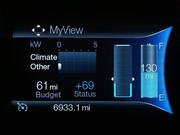
Strangely, after driving on level ground back in the valley for a mile or so at 34-45 mph, the range meter climbed even higher! (Predicting the awesomely crazy 155 miles of range on a 50% charge that I showed an image of at the beginning of this post.)
After another few miles of similar suburban driving, the surplus finally started to decrease, but it was still crazy high:
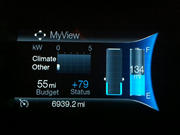
Out of curiosity, I parked and turned the car off and then back on, to see if the estimated range would persist. It did:
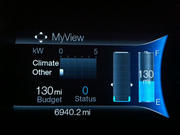
*sigh* If only this were true!
I actually drove around some more, some street and freeway, all on level ground, taking the battery down to about 10%, at which point the range estimate became somewhat more realistic (15 miles). And, as my FFE sits charging now, the predicted range for the full charge stands at 105 miles. So... while I think my FFE is probably still feeling a little giddy from all the regen today, it is done being crazy.
The trip was just for fun... plus, it has been HOT around here this weekend and at the higher elevations of Skyway Blvd it was a bit cooler... and great to drive along with the windows down. Anyway, I'd heard that driving a lot of hills make the range meter go crazy, and apparently it's true!
Anyway, I'd heard that driving a lot of hills make the range meter go crazy, and apparently it's true!
----
Edit: I suppose the thing that really stuck me about this drive was the fact that I had 50% charge upon reaching Los Gatos! At that point, I'd done about 50 miles. Starting out on the 60-mile route, I thought my FFE would probably make it, but that it might be close, given all the climbing. It wasn't close at all. Well at least the next time I do the same drive, I will be able to be much more relaxed.
Btw, while cruising through the hills, I saw a Model S and a Leaf out for a similar drive. I wonder if they recognized me as an EV.

Hehe... okay, just kidding. :lol: I still have the normal battery pack. Actually, I went for a long mountainous drive today and, apparently, doing a lot of regen (down hills) really wreaks havoc with the FFE's range meter! It ends up very confused and estimates crazy big ranges.
For those of you familiar with a SF Bay Area, I drove my FFE along Skyline Blvd in the peninsula hills, following this route:

As you can see, there are many winding roads and, as you might surmise, significant elevation changes. At the beginning, after a bit of freeway and suburban driving, the initial climb is very windy. Then, Skyline Blvd (going basically south-east) rides along the tops of the hills and is (comparatively) flat with gentle curves. At the end, more windy roads (to descend) and then finally a trip (all down hill) on Hwy 17 back into Los Gatos.
I started the trip with a full charge and a range estimate of 97 miles (high, but not uncommon for me). After the initial climb, reaching Skyline Blvd, my status was down -30 (!) and the navi said I would have a surplus of only +16 miles upon reaching Hwy 17 (which I knew, if I could reach without dying, regen would get me home). I was a little nervous (having never driven this route in my FFE before) but decided to go for it! My nerves calmed after the bulk of the drive along Skyway, at which point I was still showing a +12 surplus.
But then... with all the descending windy roads near the end of Skyline and then on Summit Road, I did a lot of "one-footed" driving in L, using regen as a form of braking in the curves (fun!). Speeds were 20-30 mph. After several miles of this, the surplus started climbing nicely... I hadn't looked at it for about 10 minutes when, lo and behold, I glanced down and it said something like +50. Whoa! I knew this was not accurate, but at least I was assured that regen was really kicking in and that I would make it to Hwy 17. Which I did.
Finally, after coming down Hwy 17 into Los Gatos, at freeways speeds (50-60 mph) doing heavy regen in L, the range meter said this:

Strangely, after driving on level ground back in the valley for a mile or so at 34-45 mph, the range meter climbed even higher! (Predicting the awesomely crazy 155 miles of range on a 50% charge that I showed an image of at the beginning of this post.)
After another few miles of similar suburban driving, the surplus finally started to decrease, but it was still crazy high:

Out of curiosity, I parked and turned the car off and then back on, to see if the estimated range would persist. It did:

*sigh* If only this were true!
I actually drove around some more, some street and freeway, all on level ground, taking the battery down to about 10%, at which point the range estimate became somewhat more realistic (15 miles). And, as my FFE sits charging now, the predicted range for the full charge stands at 105 miles. So... while I think my FFE is probably still feeling a little giddy from all the regen today, it is done being crazy.
The trip was just for fun... plus, it has been HOT around here this weekend and at the higher elevations of Skyway Blvd it was a bit cooler... and great to drive along with the windows down.
----
Edit: I suppose the thing that really stuck me about this drive was the fact that I had 50% charge upon reaching Los Gatos! At that point, I'd done about 50 miles. Starting out on the 60-mile route, I thought my FFE would probably make it, but that it might be close, given all the climbing. It wasn't close at all. Well at least the next time I do the same drive, I will be able to be much more relaxed.
Btw, while cruising through the hills, I saw a Model S and a Leaf out for a similar drive. I wonder if they recognized me as an EV.
